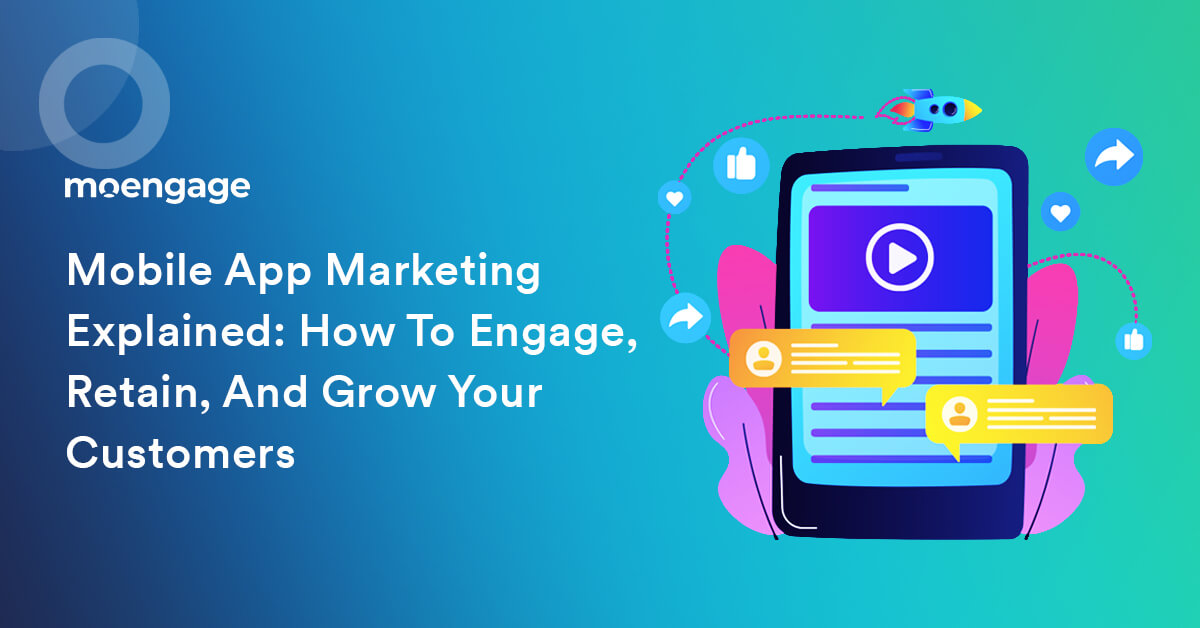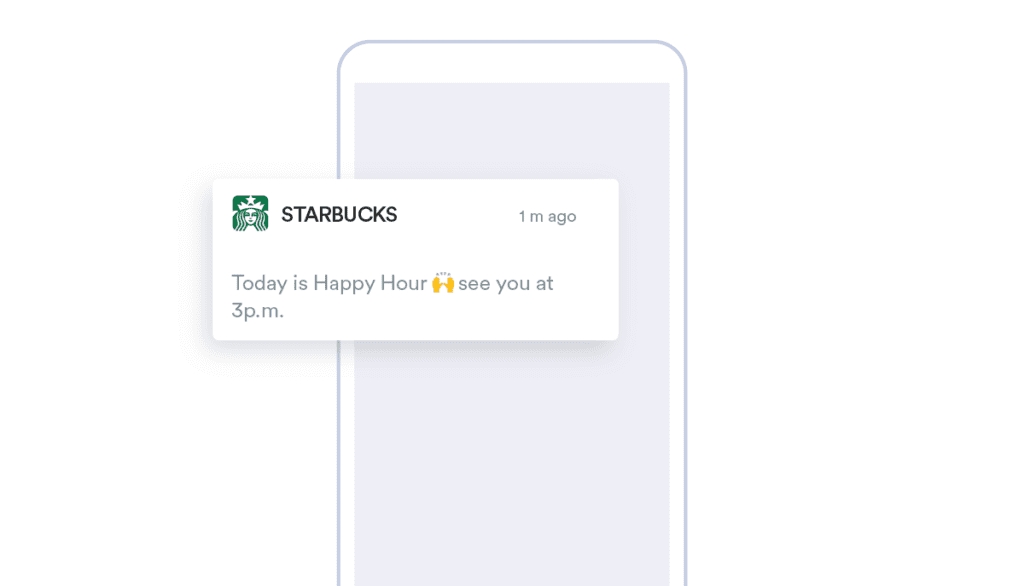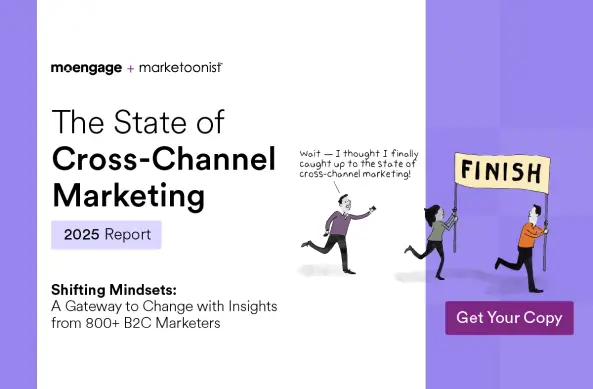Mobile App Marketing Explained: How to Engage, Retain, and Grow Your Customers in 2023

In November 2020, Starbucks rolled out a campaign to introduce its holiday-themed, seasonal favorite drinks with a tagline that read something like this:
“Festive is a tap away; download the app today:”
 |
Now, it doesn’t take a genius to understand that the campaign aims at encouraging consumers to use the Starbucks mobile app to order instead of lingering in the Starbucks outlets–the latter being an unwise choice since we are all in the thick of a global pandemic. The brand decided to give away a collectible red holiday cup to customers in the US to boost customer engagement.
| Bonus Material: Here’s an interesting case study on how OYO ran seamless customer engagement campaigns across multiple channels. |
The Results?
A. Mobile orders rose from 18% (March) to 24% (September), thanks to improvements within the app and strategic advertising campaigns that drove consumer awareness about mobile ordering.
B. The Starbucks Rewards loyalty program also saw a sharp rise in its active members, with 3 million new customers subscribing, totaling the number of members to 19.3 million.
C. According to Starbucks CEO Kevin Johnson, “90% of sales volumes in Q3 flowed through the combination of drive-through and mobile order-and-pay.”
The Learning?
Mobile app marketing, when done right, produces impactful results.
In this blog, we will look at how you can leverage app marketing, particularly in times of a recession, to engage, retain, and grow your customers in 2023. Before we move onto the three stages of app marketing, let’s look at the top trends that will redefine app marketing in 2023.
Top App Marketing Trends to Watch Out for in 2023
- According to App Annie, “at-home” categories such as education, streaming, and shopping will increase, leading to 1.3 trillion hours of consumption on Android apps in 2021.
- Apps offering video streaming and live events will dominate the app market as COVID-19 reinforces stricter social distancing norms.
- Audio marketing and podcasts will witness skyrocketing growth.
- Mobile UI/UX will become a priority for marketers looking to engage better with customers and drive customer loyalty.
Driving an app-first lifestyle will be on the cards for multiple businesses looking to leverage the already exploding smartphone customer base.
Look at the top strategies that can take your app marketing to the next level. Let’s start at the very beginning by answering the elephant in the room:
What are the three stages of mobile app marketing?
Much like your traditional marketing funnel, mobile app marketing, too, comprises the following three stages:
Stage 1: Awareness
The primary goal is to attract new customers to your app and create awareness about it in the right segments. Here are some ways in which you can expand your reach and build awareness:
- App store
- App review websites
- Paid advertising
- QR codes
- Social media
Before you build a marketing campaign targeting customers, you must zero in on your brand messaging and positioning. After all, customers connect with brands on the latter’s values and purpose, not solely through product features. So, defining your brand positioning should take priority so you can engage with customers on a deeper level. Additionally, you should identify the right channels where your customers are.
If you are unsure about how to prioritize the channels, you can refer to the bullseye framework, which includes the following four steps:
- Brainstorm: The idea is to brainstorm at least one strategy per channel to boost growth.
- Rank and Prioritize: The next step involves ranking and prioritizing strategies brainstormed in the previous step.
- Test: Once your list is ready, you can start testing your target market to see which strategies are sticking (and which are not).
- Focus: In the final step, once you’ve identified channels fueling growth, you need to keep focusing on them until you reach your end goal.
If you are wondering what would motivate customers to download your app from thousands of apps in the same vein, here are some tactics for you to try:
Top Strategies to Take Your Awareness Stage to the Next Level
1. Plan your app release date and work on your mobile app marketing strategy in advance, considering any delays or setbacks that may come your way. You should plan to:
- Understand who your ideal customers are.
- Why they should download your app.
- How you can encourage them to download your app.
| Did you know?
According to research by Google, apps are mostly discovered ‘outside’ the app store, with 52% of customers getting to know about the apps through family, friends, and colleagues. |
2. Make sure to conduct in-depth market research before developing your app. This includes looking at influential blogs, online forums, websites, and social media to understand your customers and their pain points.
3. Build an accurate customer persona that helps you understand your ideal audience, what they think about your app, and their customer journey with your app. Make sure to include demographics, mobile preferences, interests, operating system preferences, and challenges that shape your audience. Here’s an example of a mobile app persona that aims at selling a ‘social tool’ to a buyer who wants a modern app that can assist him in this mission for change:
 |
4. Engage in in-depth competitor analysis that includes comparing your top-5 competitors. You could look at their current pricing model, app store ranking, user experience (UX), app reviews, etc., to understand how your app compares.
5. Before launch, ensure that your website, a video promo with the app’s key features, and a helpful press release or blog post are ready.
6. Build a clean, attractive, and user-friendly pre-launch mobile website or a landing page, including teaser video/app screenshots that can be used across app stores, social platforms, and paid ads. Also, focus on building an email list of your customers so that you can keep them updated on new updates, features, and positive reviews to drive engagement. Here’s an example of an app landing page by Soundcloud, which ingeniously uses animated GIFs, short and crisp text, and a clear call-to-action to engage the reader.
7. Laser-focus on collaborating with authentic influencers, credible publications, and established bloggers to secure backlinks and dole out honest reviews. The better your reviews, the more consumers will be encouraged to hit the download button. An excellent example of this would be BuzzStream which partners with influencers to get feedback on features and include them in the launch. You can ask them to have a link to your landing page/press kit.
8. Go all out with promoting your app on social media platforms relevant to your audience. You can create a specific hashtag and social media posts to inspire excitement about your app.
9. Brainstorm what your content marketing strategy will look like. You can write blogs on what your app development experience has been like. Make sure to promote your blog content through personalized email marketing and focus on building trust with customers through honest and valuable content.
10. Focus on building a stellar presence on diversified platforms such as YouTube by demonstrating how customers can use your app. You can also create online tutorials and blogs to keep the momentum going and proactively address customer queries.
| Pro Tip: Go for a burst campaign. In other words, aggressively market your app launch through paid media for 24-72 hours. |
All these efforts will collectively help you customize your app, branding, in-app content, features, etc., to your customer’s needs and wants, making it an instant hit. Additionally, it allows you to:
- Present your product in a logical step-by-step sequence
- Monitor your app’s optimization in the app store
- Segment your customers
Stage 2: Conversion/Acquisition
In this stage, your goal is to encourage the customer to take the necessary action that contributes monetarily to your business. The various ‘actions’ that your customer can take include:
- Downloading your app
- Setting up an account
- Making an in-app purchase
- Using app constantly
| Bonus Material: If you wish to boost your app monetization and engagement, read the guide. |
Top Strategies To Ace The “Conversion/Acquisition” Stage
1. Focus on enhancing your onboarding experience by creating step-by-step, instruction-led content. You can also include free demos to help customers get familiar with the app instantly and effectively. Here’s an excellent onboarding example by Strava that boasts of a simple UI and presents customers with relevant tasks:
 |
2. Understand where downloads originate from. In other words, get to know the ‘source’ of your downloads.
3. Create a seamless and effortless customer experience.
4. Boost customer engagement through mobile push notifications. Here’s an example of location-based push advertising:

|
| Bonus Material: If you wish to understand how push notifications can boost engagement and subscription levels, check out this case study of the music app, Gaana. |
5. Post the app launch, and engage in paid advertising on social media platforms such as LinkedIn, Facebook, Instagram, etc. You can also go for Google Search ads.
6. Engage in app store optimization by focusing on the title of your app and by using structured and well-researched keywords. Also, include a brief description of the features and benefits customers can gain from using the app and screenshots and videos. Here’s an example of Starbucks’ mobile app store listing:
 |
7. Create a convincing pitch for Apple’s editorial team so your app can be featured in the app store.
| Pro Tip: Remember that the more your app gets downloads, the greater the chances of it ranking higher in the App Store search results. |
Stage 3: Retention
In this stage, you will want to keep your customer base happy, engaged, and loyal. Granted that downloads peak after the first few weeks of the launch, the trick lies in keeping customers engaged once the excitement dies.
To improve mobile app engagement and customer retention, focus on the following elements of your mobile app marketing:
Top Strategies for Retention Stage
1. Segment your audience and then roll out relevant in-app messaging about upcoming offers, new launches, warnings about app issues, payment failures, version upgrades, etc. Here’s an example of in-app messaging that encourages to sign up for the VIP program:
 |
2. Roll out customer surveys and reward customers for participating in the survey.
3. Drive push notifications to encourage engagement. You can send specialized content, coupons, special promotions, etc., to reel your customers in.
4. Offers customers a reward/bonus/benefit in exchange for them promoting your app online as Robinhood does:
 |
5. Ask for customer feedback by placing pop-ups strategically. Make sure to include your contact information wherever possible so customers can easily reach out to you. You can also ask your customers to give unfiltered opinions via forums on relevant sites and social media.
6. Work on the negative reviews and focus on continuously improving your app:
 |
You want to drive as many organic app installs as possible. This is why creating a strategic and in-depth mobile app marketing plan should take center stage. Here’s a detailed framework for driving app adoption and growth:
 |
| Bonus Material: Take this interactive quiz to understand whether you have a handle on measuring retention. |
Top 3 Mobile App Marketing Metrics To Keep An Eye Out For
The importance of setting goals and analyzing the quality of your app store ratings over a period of time cannot be stated enough. Most marketers gauge their app’s success (or failure) by looking at the ‘monthly downloads’ number–a big mistake. The accurate measure of your app’s success lies in measuring the following three metrics:
1. Average Number of ‘Active’ Daily and Monthly Users: Instead of simply monitoring the daily/monthly customers, you need to focus on the number of ‘active’ customers that add actual value to your business.
2. App Session Length: This refers to the average time (in seconds) your customer spends using your app, from login to session close.
3. Acquisitions Segmented by Referral Source: It signifies the ‘sources’ of your conversions so that you can understand–and justify–your marketing spend.
Wrapping Up
“Around 68% of mobile app companies have a long-term, fully documented marketing strategy.”
App marketing can strengthen your brand’s competitive advantage, especially in today’s digital age, where everything is online or remote. Digital marketing touchpoints such as apps can bolster customer engagement and meet your customer’s increasing need for convenience, safety, and familiarity–advantages that characterize every app’s positioning.
There are over 2.87 million apps available for download on the Google Play Store and 1.96 million apps in the Apple app store. Your mobile app marketing plan is your best chance to stand out in a sea of sameness.
Here’s What You Can Read Next |






 (
(
